The Ancient Ones
No, not Karin and me. The other ancient ones.
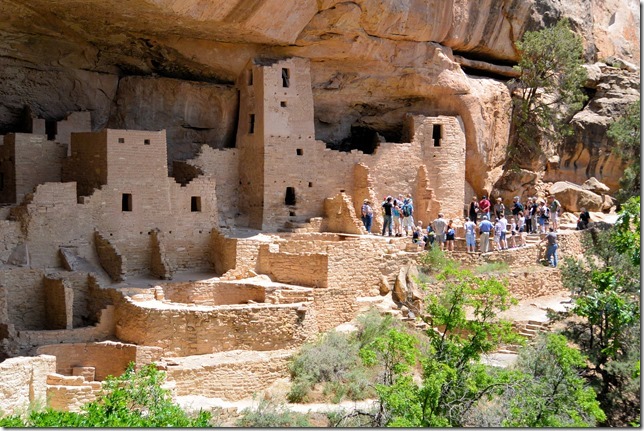
The word “Anasazi” is Navajo for “the ancient ones”. Up until recently, this was okay. Then the Utes, Hopi, Apache, etc. got upset that their ancestors were named in a (competitive tribe’s) foreign language, and began insisting that the long-dead be called “Ancestral Puebloans”. I guess English is more neutral than some other (Indian) language. So now “Anasazi” is rampant throughout literature, signage, and annotations everywhere, while Park personnel are trying to self-retrain to say “Ancestral Puebloans”.
I’ll stick with Anasazi for now. Also notice that I don’t use “native American” although this is the PC thing to do these days. As far as I’m concerned, we’re all immigrants, some sooner and some later. You cannot buy a “Native American Country Map”, but you can indeed buy an “Indian Country Map”.
All that political-incorrectness aside, I must say that Mesa Verde is a spectacular collection of early Puebloan settlements, more than I thought existed in the entire US. And we are told that there are more, far more, in the Indian Nations of the four-corners area. This area was a virtual suburban township; the four-corners area must have held thousands of dwellings and nearly hundreds of thousands of inhabitants – – at least while times were good.
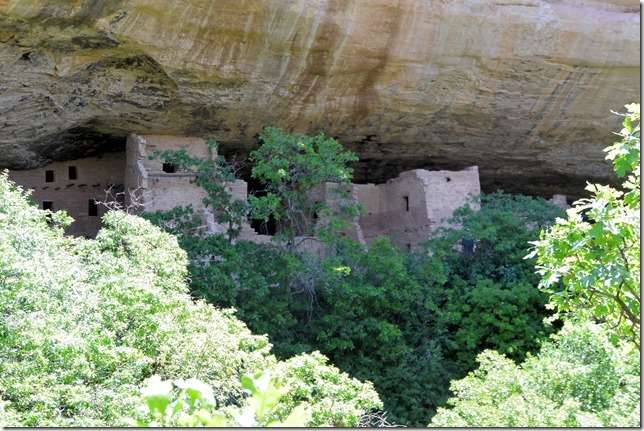
We were nothing short of astonished. What we previously thought were a few ancient enclaves, pockets of “civilization” back in the 1200AD period, was in actuality a dispersed city/state of ancient puebloans. What’s more, they lived here, pretty successfully, for about 800 years. Their nomadic hunter-gatherer ancestors were here for several thousand years before that.
Today, we walked, climbed, and scrambled on hands-and-knees to several of these well-preserved dwelling sites. Getting up close to these old stones, listening to the Ranger talks, studying the museum displays – – this gave us a vastly increased sense of the people and times that were. And they existed long before America, and for a much longer time than America has been around. This kind of History has a funny way of creeping under your skin, and we were truly impressed.
Some places had awkward, narrow, steep steps carved into the stone.
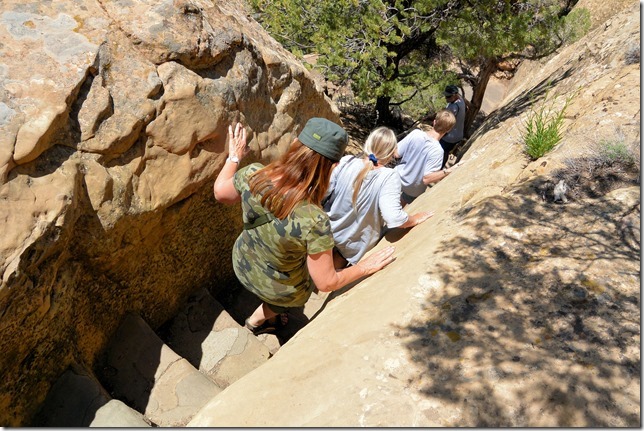
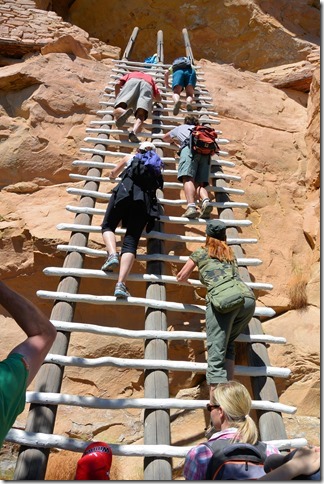 Some places had wooden ladders. Fortunately, they were NPS ladders with nice heavy bolts, not the old style held together with yucca-fiber hand-woven ropes.
Some places had wooden ladders. Fortunately, they were NPS ladders with nice heavy bolts, not the old style held together with yucca-fiber hand-woven ropes.
The Park has 50,000 acres and over 600 historical pueblo sites. That’s an average of one site for every 80 acres. There was a HUGE population here, starting around 450AD and lasting until about 1250AD. Estimates have as many as 50,000 inhabitants of this region at one point, a larger population than it holds today.
It appears that original hunter-gatherers (pre-450AD) had it pretty good, but population increase demanded agriculture, which fueled more growth. Head count continued to rise. The best current guess is that the locals moved into this cliff region from the open mesas around 1175AD, to better defend themselves and their crops from the increasing attacks and conflicts in the area. The put a TON of work into the relocation, which only lasted about 85 years.
When the 27-year drought hit, lost agricultural production caused serious impacts. People had moved to the cliffs, but even that was not long-term successful. Eventually, the entire population migrated south to the Rio Grande.
This is from the excellent Park Museum, and tells quite a story. Go Paleo!, we can learn some lessons from this.
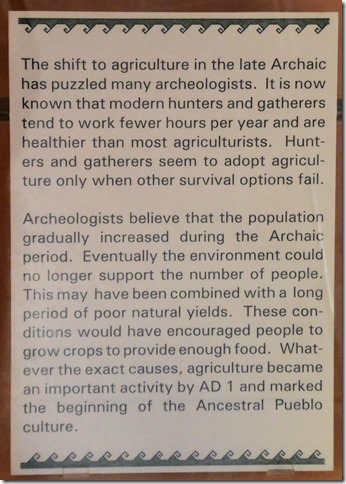
Here’s another museum keeper: ancient Indians wore clothing made from turkey feathers. Weird.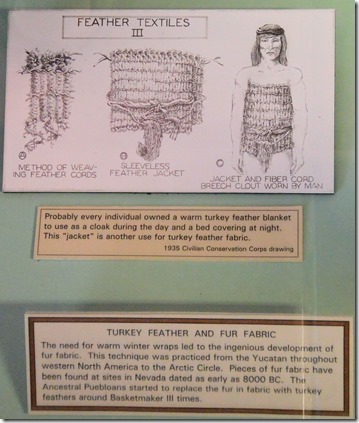
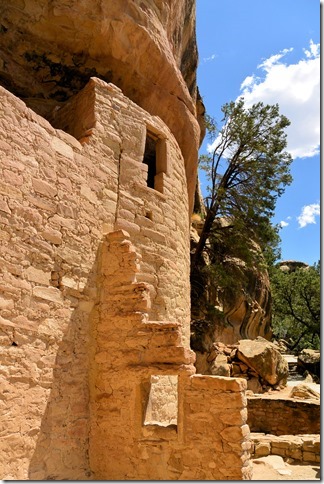
The area is a nice place to live, if you can figure out how to get through the winters. And the Anasazi did. They farmed corn, beans, and squash on the mesas above their cliff abodes. The snow-melt seeps kept them in water until the summer monsoons. Their stone/mud walls kept them warm and their foodstuffs safe.
They did have their problems, for sure. The diet wasn’t all that great, and they had plenty of health issues. All the clans were knowledgeable about local plants used for illness remedies.
One of the most insidious problems was dental. The heavy use of ground corn meant that their diet was supplied from the stone meal-grinders that were used in preparation. Sadly, these sandstone tools left a steady residue of fine dust in the corn meal, and decades of this diet ground down teeth prematurely. As they lost their ability to chew all the tough foodstuffs of their diet, their nutrition suffered. Old age meant maybe 50 or 60.
As with many third-world populations today, infant mortality was severe, on the order of 50%. This, combined with the harsh lifestyle, resulted in average life expectancies of 35 years.
Stone corn-grinding “station” in one of the public areas.
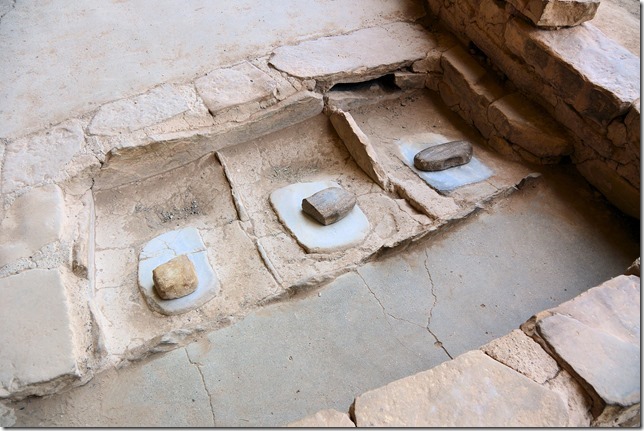
Once the population/crime increase forced the farmers to the cliff dwellings, life became even more difficult. To live in the cliff dwellings meant having to climb out of them and up to the mesas every day to deal with the farm crops. This could not be made easy, or it would tempt invaders. Consequently, access was always by toe-holds, ropes, and ladders – – and sometimes even by tunnels. Here’s an example (Square Tower House) where a series of steps and ladders some distance away was (and is) the only access path.
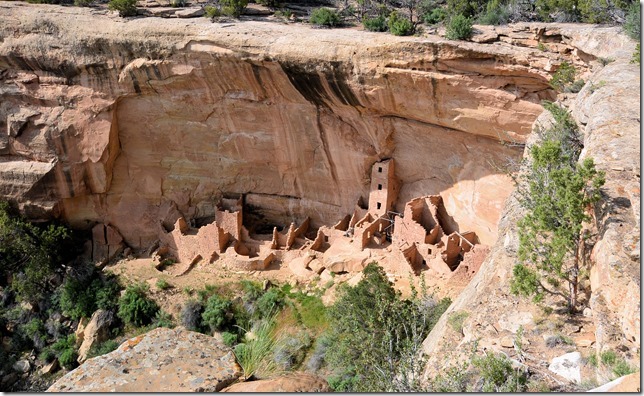
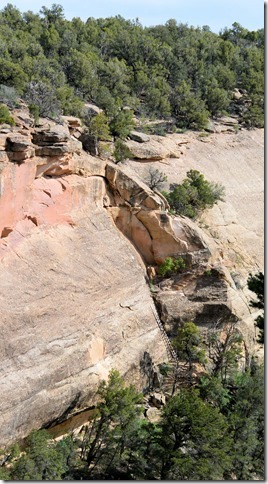
The pathway to Square Tower House is about 200 yards away. Its base ladder is just visible in the picture; other ladders and pathways reach to the forest above.
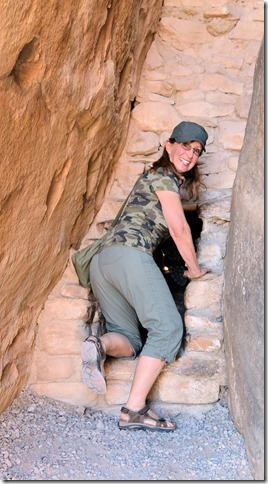
Tunnel is the only access here, roughly three feet high and 1.5 feet wide. A small child with a ball-peen hammer could defend this entry from an army of attackers.
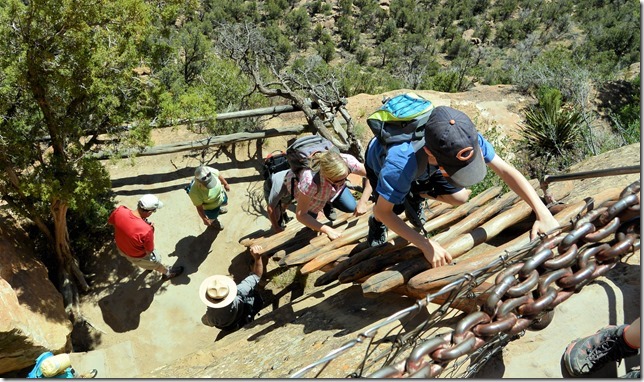
Karin disappears down the smoke-stack/entry-hole of a restored kiva.
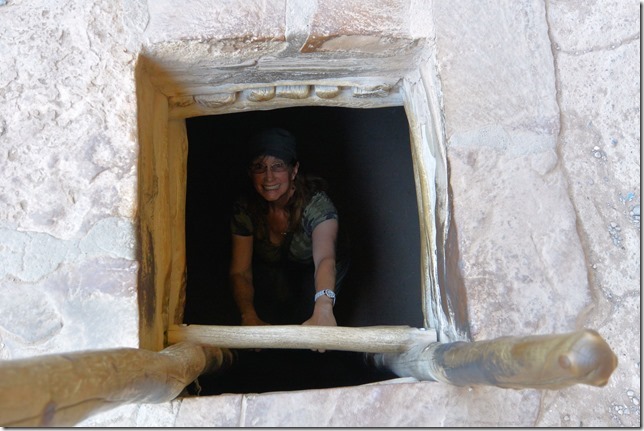
Needless to say, by the time we’d finished climbing, crawling, and lunging up these various pathways, and in 85F heat, we were pretty much busted for the day. We made three different climbs of around 500 feet each, which doesn’t sound like much but it got our attention for sure.
We spent some time enjoying some of the other features of the Park.
An old wagon near the museum café.
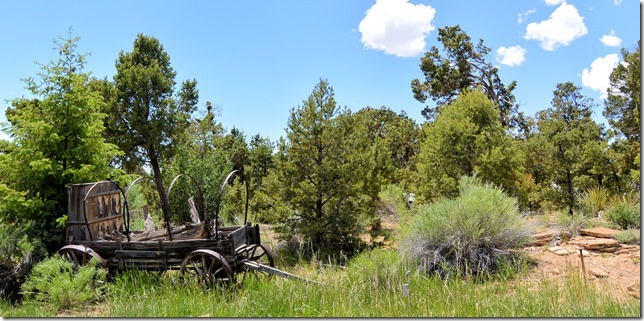
Wild turkeys at a sandstone seep, just off the road going down the mesa.
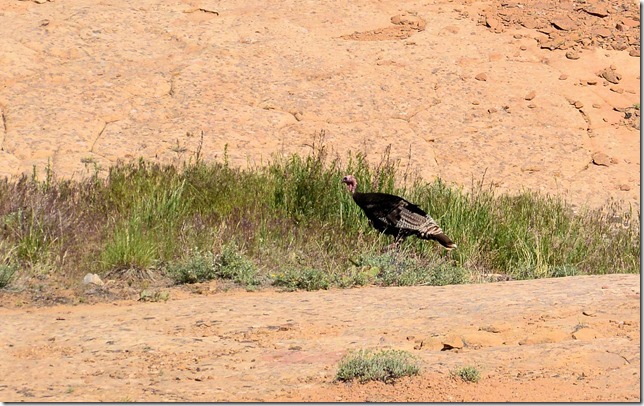
Lots and lots of game right in our campground. The deer are slightly skittish, but we could always get within 25 yards or so.
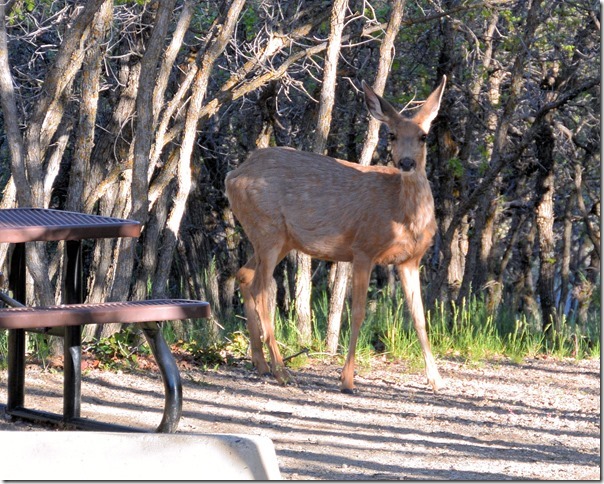
Tomorrow is a bit more kick-back, some additional gawking at the ruins and a bit of hiking. Friday we are off to Black Canyon of the Gunnison National Park. Perhaps the longest NP name on the registry, who knows.
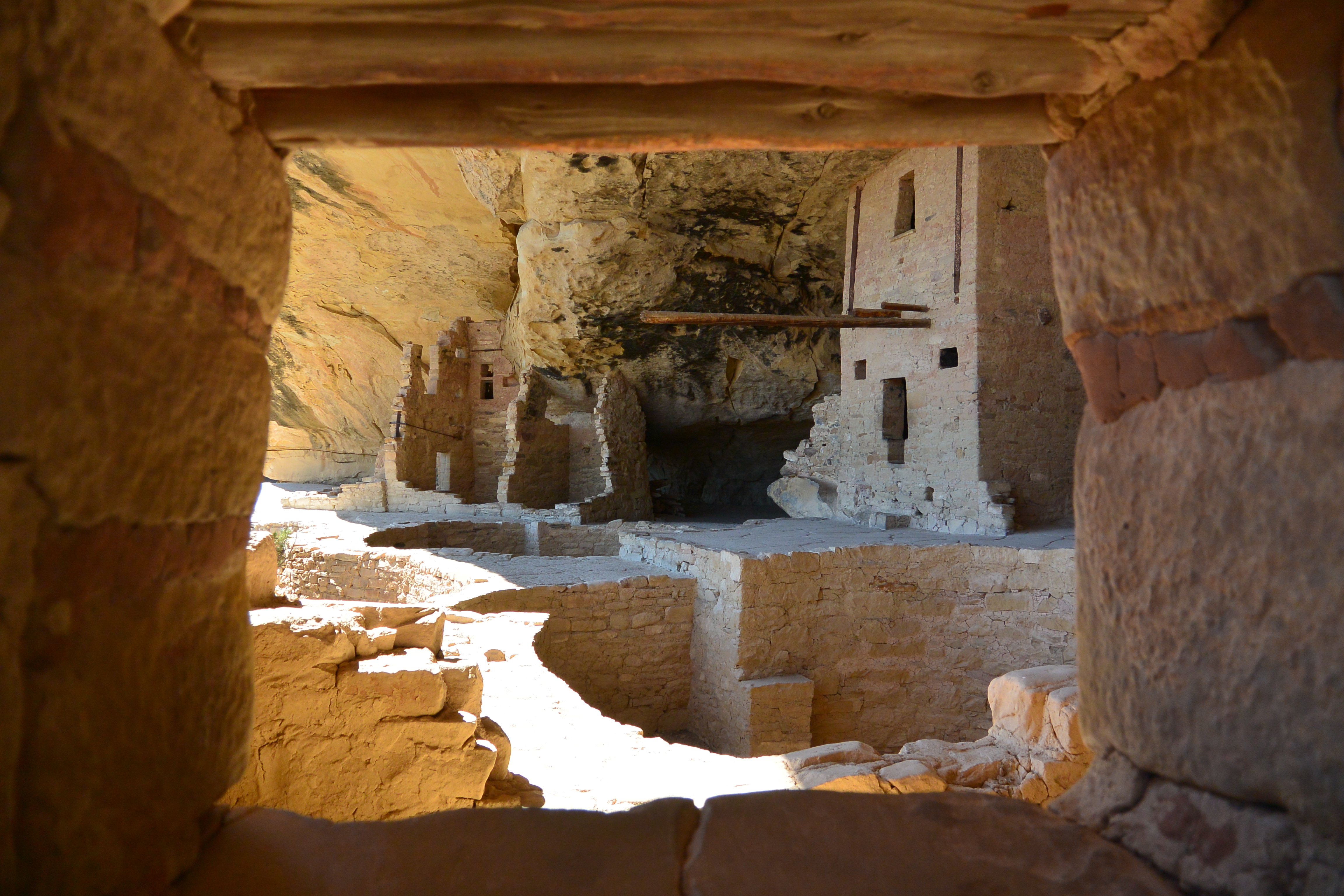
I think that everything published made a great deal of sense.
However, think on this, suppose you typed a catchier post title?
I am not suggesting your content isn’t good, but what if you
added a post title that makes people want more? I mean The Ancient Ones | DIVERSITY is kinda plain. You should peek at Yahoo’s home
page and watch how they write articlpe titles to grab people
to click. You might add a related video or a picture or two to get people excited about
what you’ve got to say. Just my opinion, it would bring your blog a
little bit more interesting.
What a wonderful park to visit! Exhausting climbs, but well worth the effort!
Very interesting. That sounds like a great place to visit. I wonder if they are open in the winter. My guess is NOT.
Yes parts of the Park are open all year.